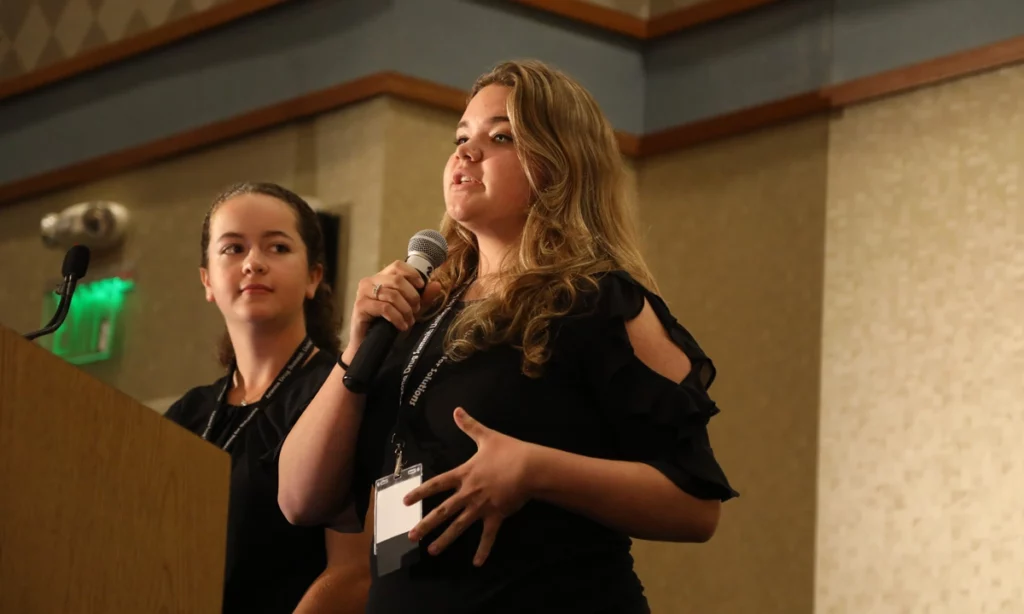Amidst the growing fentanyl crisis, the youth of Arizona have stepped up to fight against this deadly epidemic by launching various initiatives.
Arizona Teens created a “No Second Chance” PSA campaign, highlighting alarming statistics, community impacts, and the challenges they face.
It also emphasizes the significance of collaborative efforts from government agencies, schools, and parents to tackle this issue.
With its focus on community-driven action, this piece is a testament to the power of awareness and intervention in combating the drug crisis.
Teens Lead the Charge in Arizona's Fentanyl Awareness Campaign
Origins of the “No Second Chance” Campaign
This campaign didn’t start as a widespread initiative. Instead, it was birthed from a marketing club project and has since transformed into a nationally recognized fentanyl awareness program. The campaign sends a clear message: the dangers of fentanyl are immediate and profound, with just two grains amounting to a lethal dose.The Personal Connection
The compelling motivation behind this movement traces back to personal tragedies. Many students were alarmed by the increasing number of their peers falling victim to fentanyl, a topic scarcely discussed in their communities or social circles. Ethan Dukes’ story, a promising 16-year-old athlete who lost his life to a fentanyl overdose, particularly resonated, driving the campaign’s message home.Achievements and Recognition
The impact of the campaign has been both deep and wide. Collaborating with family survivors of overdose victims, prevention specialists, and drug trafficking teams, their PSAs have featured prominently on various platforms, including school announcements. This initiative even caught the federal Drug Enforcement Administration (DEA) attention, earning them the esteemed Red Ribbon award.The Changing Landscape of Fentanyl
Fentanyl, once a drug used predominantly in medical circles, is now a significant threat, especially in regions close to the border, like Maricopa County. The DEA reports an alarming rise in counterfeit pills containing fatal fentanyl doses. Alarmingly, many teens procure these pills from unsuspecting sources like social media or peers, unaware of their deadly nature.Community Response and Future Steps
The response to the campaign has been overwhelmingly positive. Schools within the Tempe Union District now have Narcan doses ready, and students and staff are trained in their administration. The initiative has sparked a broader conversation about drug awareness, prevention, and the need for further community action.Community Action Against the Fentanyl Crisis
The “No Second Chance” campaign, led by teenagers, underscores the pressing need for awareness and action in the face of the fentanyl crisis. Their efforts stand as a testament to what community-driven initiatives can achieve, reminding us of the gravity of the situation and the power of informed action.Teenage Addiction and Overdose
| Topic | Details |
| Overdose Deaths in Teens | According to a CDC report, among 10 to 19-year-olds, fentanyl-related overdose deaths increased by 182% from 2019 to 2021. |
| Opioid Crisis in the U.S. | In 2019, nearly 70% of the 70,630 drug overdose deaths involved an opioid. On average, 128 Americans die every day from an opioid overdose. |
| Youth and Opioids | According to the 2019 National Survey on Drug Use and Health (NSDUH), 3.5% of adolescents aged 12 to 17 reported misusing opioids over the past year. |
| Synthetic Opioids | Synthetic opioids, including fentanyl, are now the most common drugs involved in drug overdose deaths in the U.S. In 2019, two out of three opioid-related deaths involved synthetic opioids. |
| Factors Influencing Teen Overdose | Many overdoses in teenagers come from drugs laced with fentanyl. Often, these individuals believe they’re taking a less harmful drug, not realizing it’s been combined with this potent synthetic opioid. |
| Unintentional Overdoses | A significant majority of these overdoses are unintentional. In 2021, less than 1% of synthetic opioid deaths were ruled a suicide, emphasizing the accidental nature of these tragedies. |
The alarming increase in addiction among teenagers has become a pressing public health concern in recent years.
The vulnerability of this age group, coupled with the ease of access to prescription and illicit drugs, has created a dangerous cocktail of risk factors.
In addition, the rising prevalence of potent synthetic opioids, such as fentanyl, in the drug market has escalated the stakes.
These substances can be many times more potent than the drugs teenagers believe they are consuming, often leading to inadvertent overdoses.
Recent data shows deaths from fentanyl overdoses in children aged 10 to 19 surged 182% between 2019 and 2021.2
This upsurge in teenage addiction and the associated rise in overdose deaths call for immediate, comprehensive interventions encompassing education, prevention, and support.
The Fentanyl Crisis in Arizona
The state of Arizona is grappling with a devastating wave of fentanyl-related issues, epitomizing a broader national crisis.
The illicit proliferation of this potent synthetic opioid has left an indelible mark on communities, families, and individuals alike, reshaping the contours of the region’s public health and safety landscape.
The Alarming Rise in Fentanyl-Related Overdoses
Fentanyl, known to be 50 to 100 times more potent than morphine, has been linked to an increasing number of overdose cases in Arizona.
With its surreptitious presence in various street drugs, unsuspecting users often consume it, leading to accidental overdoses.
Many are unaware of its potency or presence in what they believe to be less harmful drugs, making the danger it presents both silent and deadly.
Key Statistics and Trends
According to a Washington Post analysis of 2021 CDC data, fentanyl is now the primary cause of death for Americans aged 18 to 49.
This exponential rise underscores the ubiquity and penetration of fentanyl in the drug market.
Furthermore, as of 2019, two-thirds of opioid-related deaths involved synthetic opioids like fentanyl, reinforcing its central role in the opioid crisis gripping the state.3
The Impact on Communities, Families, and Individuals
Beyond the cold statistics lies a heartbreaking narrative of shattered families, lost potential, and communities in turmoil.
Every overdose statistic represents a loved one: a son, a daughter, a friend, or a neighbor.
Families are left grappling with the unexpected loss, often unaware of their loved one’s drug use or the deadly nature of what they consume.
Communities feel the reverberations through increased healthcare demands, strained emergency services, and the broader socio-economic impact.
Moreover, the stigma surrounding drug use and addiction further isolates victims and their families, creating barriers to seeking help or discussing the issue openly.
The situation in Arizona serves as a dire warning and underscores the need for coordinated action, greater public awareness campaigns, and accessible treatment and prevention programs.
Overcoming Challenges
Numerous hurdles impede intervention efforts’ effectiveness in the battle against rising drug addiction rates.
Firstly, addressing skepticism and resistance is paramount.
Many still view addiction as a personal failing rather than a complex interplay of biological, environmental, and societal factors.
This perspective often inhibits the acceptance and support for evidence-based intervention strategies.
Secondly, stigmatization and misinformation further complicate the landscape.
The label “addict” can ostracize individuals, making them less likely to seek help or admit to a problem.
Misinformation, often increased through social media or word of mouth, can downplay the dangers of certain drugs or popularize myths about addiction and recovery.
Lastly, while teen-led initiatives bring a fresh, relatable perspective to awareness campaigns, they also come with inherent limitations.
Their reach might be confined to their immediate peer groups, they may lack resources or expertise in certain areas, and they might face challenges in gaining the trust and cooperation of adults or authorities.
Despite these challenges, these young advocates’ passion and firsthand perspective can offer invaluable insights and innovative solutions to address the crisis.
The Importance of Collaboration
Combatting the multifaceted challenges posed by drug addiction necessitates a collaborative approach, leveraging the strengths and resources of various stakeholders.
Partnering with local government agencies ensures initiatives are backed by legislative support, benefit from public resources, and can be effectively integrated into more extensive community-based strategies.
Schools and educational institutions serve as crucial touchpoints, as they interact with young individuals during formative years and can influence behaviors and attitudes towards drug use.
These institutions can facilitate evidence-based education, early detection of drug use, and timely interventions.
Additionally, engaging parents and community organizations amplifies the reach and impact of awareness campaigns.
Parents, the primary influencers in a child’s life, can reinforce positive behaviors and seek early interventions if informed correctly.
Meanwhile, community organizations can offer localized solutions, provide resources, and create a support network for those affected.
A collective and coordinated effort ensures that interventions are holistic, sustainable, and far-reaching in their impact.
Empowering Change: The Ripple Effect of Youth Advocacy
The teen-led “No Second Chance” PSA campaign is meant to raise awareness on the devastating impact of fentanyl overdoses and serve as a testament to the difference community-driven efforts can make.
However, the battle against fentanyl and its repercussions is far from over.
The relentless rise in fentanyl-related incidents underscores the pressing need for continued awareness and proactive measures.
Individuals, communities, and institutions must take inspiration from such initiatives and rally together, amplifying efforts to combat this deadly epidemic and safeguard future generations.
If you or a loved one is currently grappling with addiction, help is within reach.
Cornerstone Healing Center is a one of the best addiction treatment centers in Arizona.
With a specialized focus on holistic healing, they delve deep into the underlying trauma of addiction, aiming to foster enduring recovery and transformation.
Let us help you today!







